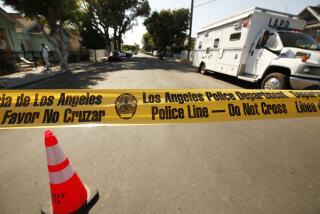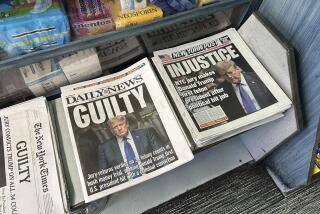AFTERSHOCKS - PHYCHIC AND OTHERWISE : The Power of Rumors: Middle Ages Revisited
BOSTON — In medieval times, there was the Roman Catholic Church. But otherwise, there was no center to hold, so virtually every idea possessed some currency. As Lewis Lapham wrote recently, storytellers blurred the distinctions between truth and fiction with their allegorical tales of animals and saints. Belief was more important than knowledge and few people could read. Natural disasters and plagues mesmerized the public, and chaos was frequently the normal state of things. When something went bad, the response was often to start a witch hunt.
Every day, our culture seems to become more like the Dark Ages. So it seemed fitting that strange apocalyptic rumors swept Southern California in the wake of the Northridge earthquake. First, there was a widely circulated and accepted rumor that a secret fax was sent from the California Institute of Technology to the governor’s office four days after the disaster, warning of an 8.5 quake within 72 hours. (Never mind that Caltech never predicts quakes.)
Then, it was widely repeated that the actual magnitude of the quake was 7.8, not 6.6 as reported, and “the powers-that-be” were keeping this a secret for fear it would be bad for business and would psychologically scar the city.
Though the details have obviously been modernized, there is something medieval about all this. We live in yet another era of atomization, which celebrates the baby-boom version of the Middle Ages’ mysticism, love of spectacle and promotion of feeling over thought. In a boomer world where “the personal is political,” everything, by definition, is in play. In such an atmosphere, what would really be surprising is if there were no wild, conspiratorial rumors sweeping the region after an earthquake. If we can no longer blame Satan for our troubles as we did a millennium ago, there’s always Caltech or Pete Wilson.
Rumors, of course, are nothing new in American life: Thousands tried to close their accounts during the Great Depression as rumors of bank failures spread, and the baby boomers spent much of their formative years comparing notes on the apparent but unreported death of Paul McCartney. (“Turn me on dead man.”) Widely accepted rumors tend to follow the panic that ensues in mass disasters--particularly when official organs of communication are impaired. In the minutes after John F. Kennedy’s assassination, for example, there were wild stories exchanged in workplaces and schools about who else had been in the car, or where else the assassin might strike.
Psychologists tell us that rumors get started for a lot of reasons--attempts to explain troubling news, misunderstandings, a desire for communion and sometimes just plain mischief. But a culture that continues to spot Elvis, still scandal-mongers about Kennedy’s death, obsessively speculates about what Michael Jackson and Tonya Harding really did and gobbles down vitamins based on “hearsay” medical evidence is obviously fertile ground for rumors of any sort--medievalism notwithstanding.
Part of the reason is that public cynicism about authority figures is so great. Rumors tend to arise when we don’t believe what “officials” tell us. One can point to a variety of factors that have contributed to the current cynicism--from Watergate, to the baby boomers’ distrust of authority, to the media’s pervasive compulsion to tear down public figures. Americans--anti-Establishmentarians at heart--have never had much use for officialdom, anyway. But the bottom line is that everyone from the press, to priests, to Presidents now has a gaping credibility gap.
Part of the problem is that the media hierarchy has collapsed. In the old era of three networks and only a few other quasi-official information sources, people tended to get their news from the same places, which then functioned as gatekeepers. When Walter Cronkite said, “That’s the way it is,” it was, in part, because there weren’t a lot of other sources of information that could compete with him.
But now the news bombards the public from thousands of equally credible, or better yet, incredible sources--not the least of which are public computer networks that operate faster than television and have no restrictions on the flow of information. Welcome to the misinformation highway.
The mainstream press no longer does a thorough job of distinguishing fact from rumor or fiction. In the not so recent past, there was a need for news only several times a day--to fill a newscast or an edition. Now, with 24-hour cable news services and far more news shows on the networks, there is a greatly increased demand for “news.” One result has been a broadening of what is considered reportable--with the result that everything from speculation about Bill Clinton’s alleged sexual escapades to Tonya Harding’s motives is presented on an equal footing with what really happened.
Add to these developments the propensity of reality-based television to blur the lines between documentary and drama on shows such as “Rescue 911” and scores of docudrama mini-series, and it’s no wonder that the public doesn’t know anymore what and whom to believe.
It is no coincidence, of course, that all these forces have converged in recent days in Los Angeles. It is, after all, the entertainment capital--our source of myths and legends, which psychologists tell us are themselves close cousins of rumor. Unlike other nations, America has always been a country built around an idea--a series of myths or rumors, some might say--and nowhere have those myths become a more formative force than in Southern California: Hollywood, Disneyland, the West, Garden of Eden, the apocalyptic End of the Road and Frontier.
As the center of the entertainment culture, it’s not just that Southern California has always had a propensity to believe --falling head over heels for the hype that is America. It’s that more than other places, Los Angeles originated and thrived on artifice--whether the artifice concerned how the water actually got there, or how the stars really lived. In a culture of illusion, cinematographers and skillful rumor-mongers flourished: Where else would Oliver Stone, peddling conspiracy rumors, be considered a prophet, or Orson Welles--who created perhaps the greatest rumor scare in American history (the Martians are coming!)--have found his true vocation? Even Welles’ great unfinished documentary, “It’s All True,” was a staged docudrama with a fabricated subplot.
It’s no coincidence that the region’s most notable political export, Ronald Reagan, was notorious for the way he sunnily presented the local affliction--unable, at times, to discern rumor from fact, entertainment from news, fiction from truth. Does Reagan really believe he liberated concentration camps, or better yet, was in the dark about Iran-Contra? Live in that world of illusion and rumors long enough, and you begin to believe in what you believe.
And so it goes in Los Angeles, with its earthquake rumors. “Everybody says it, and what everybody says must be true,” wrote James Fenimore Cooper, who understood the American myth-making culture of rumor even before there was one. The need to pass along a conspiratorial, apocalyptic explanation of an event like an earthquake is partly human nature, partly our anti-Establishment heritage, partly a throwback to medieval times and partly a reflection of the media world.
But it also shows the irresistible temptation, particularly in the mythic capital of entertainment, to take an event and immediately begin reprocessing and hyping it in bigger and bolder ways--for film at 11, a mini-series or just to tell a friend. The rumor gives magic, order, grace and grandeur to an event, just as the Hollywood version is always better than the original. As they said in the movie, “The Man Who Shot Liberty Valance”: “This is the West, sir. When the legend becomes fact, print the legend.”
More to Read
Sign up for Essential California
The most important California stories and recommendations in your inbox every morning.
You may occasionally receive promotional content from the Los Angeles Times.










